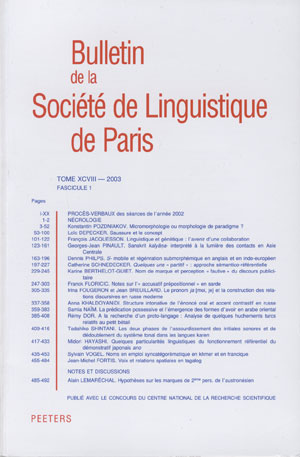 previous article in this issue previous article in this issue | next article in this issue  |

Preview first page |
Document Details : Title: Formation des composés de rection verbale du type védique bharádvāja-, grec Φερέπτολις Author(s): PINAULT, Georges-Jean Journal: Bulletin de la Société de Linguistique de Paris Volume: 113 Issue: 1 Date: 2018 Pages: 329-369 DOI: 10.2143/BSL.113.1.3285472 Abstract : Les langues indo-européennes anciennes ont différents types formels de composés de rection verbale à premier membre régissant. Un des plus problématiques est représenté par le type indo-iranien à premier membre en °at- (védique °át-): véd. bharádvāja- «emportant le prix de victoire», av. vanat.pəṣ̌ana- «remportant la bataille». Sur le plan purement formel, cette séquence a été interprétée à partir d’une forme verbale fléchie (*°e-t), ou bien mise en relation avec *-nt-, l’allomorphe du suffixe *-e/ont- de participe actif ou d’adjectif verbal. Ces hypothèses reposent sur des théories différentes relatives à l’origine de ces composés et de leur syntaxe sous-jacente. L’analyse de la distribution des premiers membres de composés en °at- en védique ancien, avestique et vieux-perse montre que le type de composé, soit possessif (bahuvrīhi), soit composé de rection verbale, dépend entièrement de la valence du verbe sous-jacent au dérivé en °at-. Il est proposé de tirer ce type de composé de rection verbale de composés doublement possessifs, avec un abstrait en premier membre, ce qui permet d’expliquer l’interprétation factitive qui est souvent constatée, comme pour les composés à premier membre en *-ti- (types véd. dāti-vāra-, gr. βωτιάνειρα et τερψίμβροτος), qui repose aussi sur un nom d’action. Le premier membre indo-iranien en °at- (véd. °át-) est expliqué à partir d’abstraits en *-t- dérivés d’adjectifs verbaux thématiques (type véd. sravát- «flot»), ce qui permet de rendre compte du déplacement d’accent sur la dernière syllabe du premier membre en regard des formes verbales associées, cf. véd. bharát- (< *bher-é-t-) vs. injonctif présent 3e sg. act. bhárat et participe présent act. bhárat-, thème faible de bhárant-. En proto-grec, cette formation fut identifiée à l’injonctif présent, qui est conservé dans les formes du type gr. φερέπτολις < *φερέτ-πολις. Le nom propre véd. Jamád-agni- est analysé selon le même schéma, comme reflétant un composé factitif qui signifiait originellement «faisant venir le feu (sur terre)». The Indo-European languages have various types of verbal governing compounds depending on the shape of the first governing member. The Indo-Iranian type of first member ending in °at- (Vedic °át-) has been much discussed without cogent solution, see the well-known examples Ved. bharádvāja- «carrying off the victory prize», Av. vanat.pəṣ̌ana- «winning battles». From the mere formal point of view, Indo-Iranian °at- has been interpreted either as going back to an inflected verbal form (PIE *°e-t), or identified with *-nt-, the weak allomorph of the suffix *-e/ont- of active participles and verbal adjectives. These scenarios are based on alternative theories concerning the origin of the verbal governing compounds and their underlying syntax. The review of the distribution of the first members in °at- in Ancient Vedic, Avestan and Old Persian shows that the resulting type of compound – either possessive (bahuvrīhi), or verbal governing compound ‒, depends entirely on the valency of the verb which lies at the basis of the °at-derivative. It is claimed that this type of verbal governing compound goes back to double possessive compounds, featuring an abstract as first member, which accounts well for the factitive interpretation observed in several instances. Their origin is then similar to the one of the verbal governing compounds with *-ti- as first member (types Ved. dāti-vāra-, Gk. βωτιάνειρα and τερψίμβροτος), with can be identified to the action nouns in *-ti-. The first member in Indo-Iranian °at- (Ved. °át-) can be traced back to *-t-abstracts derived from thematic verbal adjectives (type Ved. sravát- ‘stream’). This allows to account for the accent shift on the last syllable which is characteristic of these first members, by comparison with the verbal forms, cf. Ved. bharát- ‘carrying’ (< *bher-é-t-) vs. present injunctive 3rd sg. act. bhárat and present participle bhárat-, weak stem of bhárant-. Both associations remained alive in synchrony. This formation was identified with the present injunctive 3rd sg. act. in Proto-Greek, as it is reflected by the type Gk. φερέπτολις < *φερέτ-πολις. As a confirmation of this scenario, the proper name Ved. Jamád-agni- is analyzed along the same syntactic pattern, as meaning originally ‘having the fire with coming’, hence ‘letting the fire come’ (on earth), which fits the mythological figure who bore this name. Die indogermanischen Sprachen gebrauchen verschiedene Typen von verbalen Rektionskomposita. Der Aufsatz konzentriert über das indo-iranische Typus mit dem regierenden Anfangsglied in °at- (Vedisch °át-), z.B. Ved. bharádvāja- «der den Siegespreis davon trägt», Av. vanat.pəṣ̌ana- «die Schlacht gewinnend». Die bezüglichen Hypothesen haben keine allgemeine Zustimmung getroffen. Es wird gezeigt, daβ die Verteilung der alternativen Typen von indo-iranischen Komposita (entweder Bahuvrīhi oder verbales Rektionskompositum) mit Anfangsglied in °at- von der Valenz des unterliegenden Verbums abhängt. Die Struktur dieser Komposita ist auf Doppelpossessiva mit Abstrakta im Anfangsglied begründet, ähnlich zu den Komposita mit Nomina actionis auf *-ti-. Das indo-iranische erstes Glied in °at- (Vedisch °át-) war ursprünglich mit einem Abstraktum in *-t- identisch, das von thematischen Verbaladjektiva abgeleitet wurde, z.B. Ved. sravát- «Strom». Damit kann man erklären die reguläre Akzentverschiebung auf der letzten Silbe des ersten Glieds in dieser Kategorie von Zusammensetzung, abweichend von dem Akzent des verbundenen Verbalstamms. Dieser Stamm in uridg. *-é-t- wurde sekundär entweder mit dem Injunktiv Präsens oder, speziell im Indo-iranischen, mit dem Stamm des Partizips gleichgesetzt. Diese Rekonstruktion ermöglicht eine genauere Interpretation von mehreren Wörtern, Epitheta und Eigennamen überhaupt, zu gewinnen. |
|


